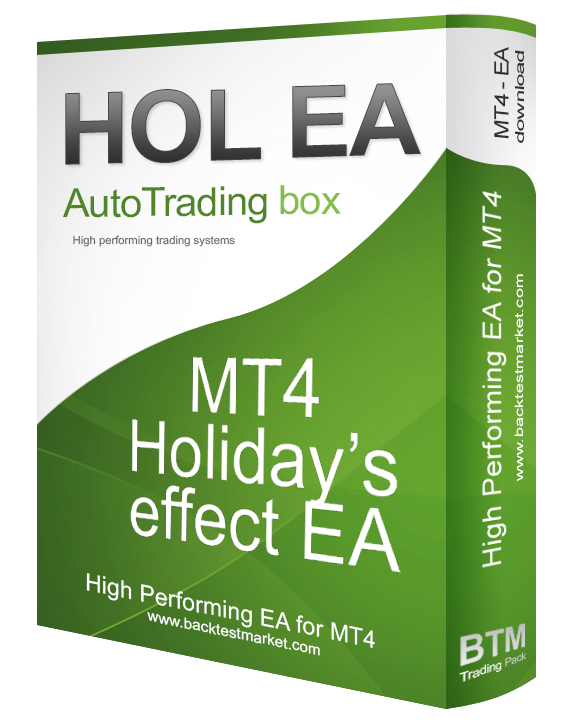Holiday’s effect (HOL)
Holiday's effect evaluate the returns of a Ticker in the days around Holidays.
Introduction
Holidays are studied both in the days that precede and follow the public Holidays, such as Christmas and New Year. In fact:
- days preceding holidays are generally associated to a positive mood, which cause a greater propension to risk. Instead,
- days following holidays are generally associated to a negative mood and so more aversion to take risks.
ForecastCycles Holiday's Strategies
In ForecastCycles, Holiday's effect is studied through 3 different families of Holiday's strategies:
- HOL "A" strategies:
- A stands for After an Holiday
- enter X days after the Holiday and exit Y days after the Holiday.
- For example, HOL_A_1_3
- enters at the opening price of the 1st trading day after the Holiday
- and closes the position at the closing price of the 3rd trading day after the holiday.
- HOL "B":
- B stands for Before an Holiday
- enter X days before the Holiday and exit Y days before the Holiday.
- For example HOL_B_3_1
- enters at the opening price of the 3rd trading day before an Holiday and
- closes the position at the closing price of the trading day preceeding the Holiday.
- HOL "C":
- C stands for aCross an Holiday
- enter X days before the Holiday and exit Y days after the Holiday.
- For example, HOL_C_3_3
- enters at the opening price of the 3rd trading day before an Holiday and
- closes the position at the closing price of the 3rd trading day after the holiday.
Which Holidays for different Tickers
Each finiancial instrument, in general, has its own set of Holidays according to its country:
- Stocks (Apple, Adidas, etc.),
- Stock Indices of a country (S&P 500, Dax),
- Government Bonds (US Treasuries, Bund) and
- ETFs
have Holidays of the country to which they belong, for example S&P 500 has the United States Holidays, Bund has Germany Holidays.
There are particular rules for regional Stock Indices, Forex, Commodities, Cryptocurrencies.
- European stock indices (EuroStoxx) have the most common european Holidays.
- Forex pairs have the Holidays of two countries, for example AudJpy has the Holidays of Australia and Japan.
- Commodities and Cryptocurrencies have the Holidays of United States.
Literature review
First Research
Qadan et al. studied in their paper “Seasonal patterns and calendar anomalies in the commodity market for natural resources” the Holidays effect in commodities, and they found significant results for several commodities in different Holidays.
They indicate with:
- P1 the “pre-financialization period”, which starts in 1896 and ends in 2003. While they call
- P2 the “financialization period”, which starts in 2004 and ends in 2018, the current year when they did the research.
Around Christmas days, they found a significant increase in commodity prices, more prominent after 2004:
“One of the most compelling pieces of evidence for the existence of market inefficiency is the seasonality of returns around Christmas. As results indicates, commodities follow this trend and in fact confirm the hypothesis that the positive sentiment associated with Christmas will be accompanied by an increase in commodity prices. Note that the stock market is closed on Christmas itself, so the response in returns is captured on the first trading day after Christmas.
In fact, during the full sample period, each of the metals studied here (excluding natural gas) is accompanied by positive returns on the first trading day after Christmas. Looking at each sub-period, one can see that the positive sentiment that prevails around holidays (Qadan and Aharon, 2018) is more prominent in the period of the financialization of commodities (P2, post 2004).
The sign test results reported provide strong support for our story as evidenced in the large ratios reported on the days before and after Christmas. These findings suggest that the precious metals market is generally inefficient because it consistently yields significant positive returns around this holiday period.”
They get significant results also around New Year's Day:
“The findings also demonstrate positive returns around New Year's Day. Investors' anticipation of a fresh start to the year may be associated with optimism reflected in the positive returns. In the total sample period (P1+P2), all commodities, but the natural gas, are associated with positive returns. Gold, palladium, platinum, and oil are statistically significant.
As the significance level of the abnormal returns indicates, these findings are more evident in the financialization period (P2) than the prior period (P1). Though we might expect that the financialization period would be characterized by more efficiency (i.e., insignificant returns), the empirical evidence here shows the opposite and contradicts the efficient market hypothesis.
They argue that contrary to literature and logic expectations, the financialization period has generally increased anomalies in the commodity markets and reduced their efficiency. They attribute this “paradox” to the increased liquidity that permits more volatility, which sometimes assume a defined direction:
“During the financialization of commodities era many international portfolio and hedge fund managers, as well as retail investors, increased their exposure to commodities. […] Our results are robust for different estimation procedures and subsamples. Though we might expect that the financialization period would be characterized by more efficiency (i.e., insignificant returns), the empirical evidence here shows the opposite and contradicts the efficient market hypothesis.
The literature argues that the more liquid the market the more efficient it should be, but results show the contrary. However, one possible “dark side” of liquidity is that it permits inefficiency, which is evident in the returns on metals regarding calendar anomalies. In the same way, sometimes illiquid securities might not appear to be volatile because there are no transactions that can express the true degree of their volatility. In contrast, liquidity does reveal the true volatility of a stock. Similarly, the financialization period may act as an “alignment mechanism” (Aharon et al., 2017) that allows the appearance of abnormal returns around New Year's Day.”
They are saying that liquidity may act like an anomaly revealer.
Second Research
Fang et al., in their paper “School Holidays and Stock Market Seasonality", investigated US stock market indices around Labor market day, noticing that the days after this Holiday:
- is the first Monday in September, and coincide for most of the people with the end of the summer and “the start of a new season”: the return to the normal working and schooling life.
- it has started most of the times a period of significantly negative returns on US stock market indices.
“In the United States, Labor Day (the first Monday in September) is typically associated with the formal conclusion of the summer season, especially in the northeastern part of the country. Many public schools and universities start the new academic year after this school holiday. If the weak market-level return we find is related to school holidays, we should see that the so-called September effect in the United States is concentrated in the days after Labor Day.
To test this, for each year from 1962 to 2012, we identified the exact date of Labor Day. We split the September dates into before and after Labor Day, and test that the weak September return is concentrated after Labor Day. Univariate results confirm our conjecture. In fact, the average daily returns for the days before Labor Day are positive. The average daily returns for the days after Labor Day are mostly negative and the differences are significant. Thus, not all September days are equal when it comes to returns. The weak returns are concentrated after Labor Day.”

Holiday's effect - MT4 Expert Advisor
Interesting periods to be studied are the days that precede and follow public holidays, such as Christmas and New Year.In fact, days preceding holidays are generally associated to a positive mood, which cause a greater propension to risk. Instead, the days following holidays are generally associated to a negative mood and so more aversion to take risks
To trade automatically this anomaly, you can purchase the "HOL Expert Advisor". The Expert Advisor needs the "Main EA and libraries" to work. If you have an active ForecastCycles membership, contact us to get 20% discount.




